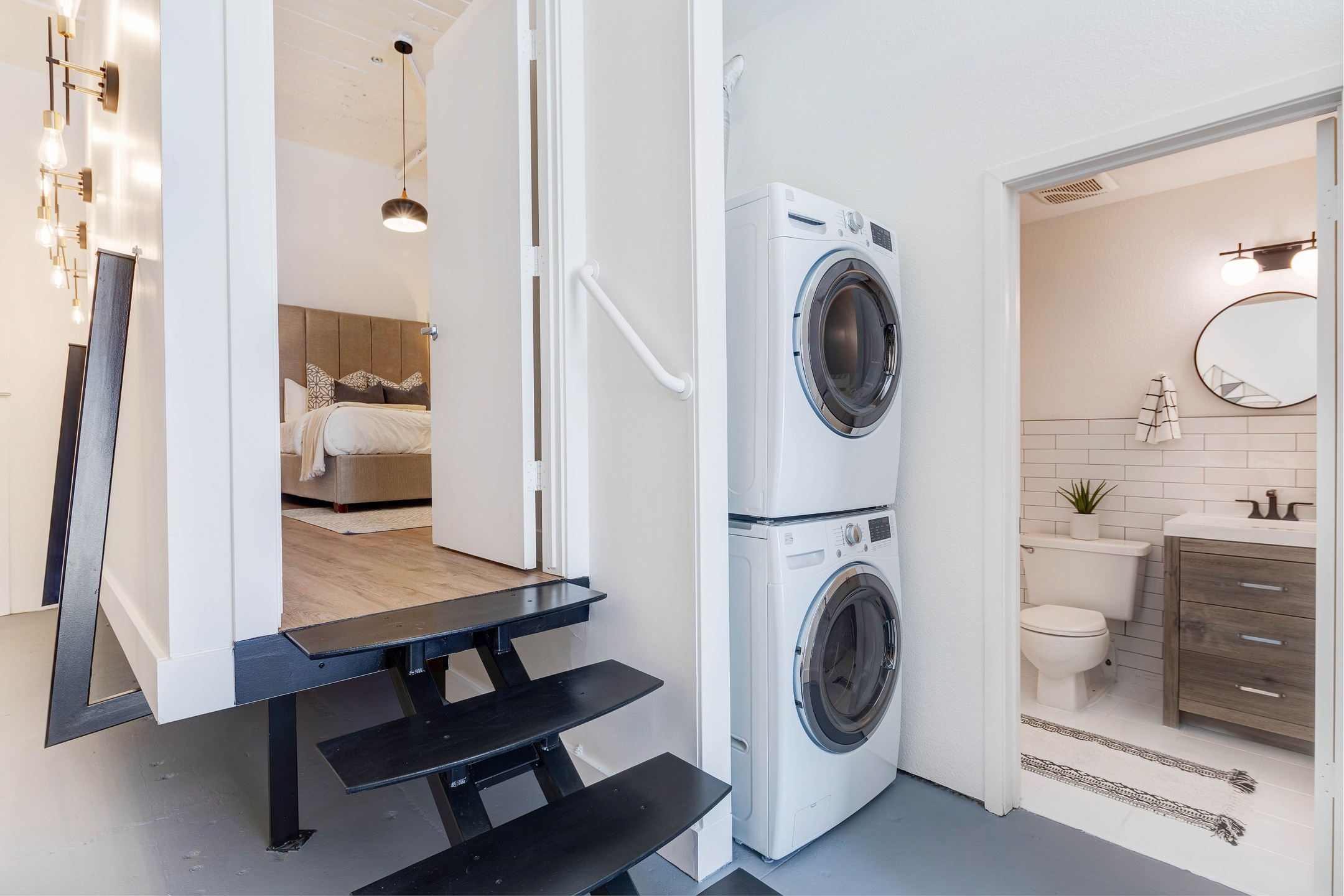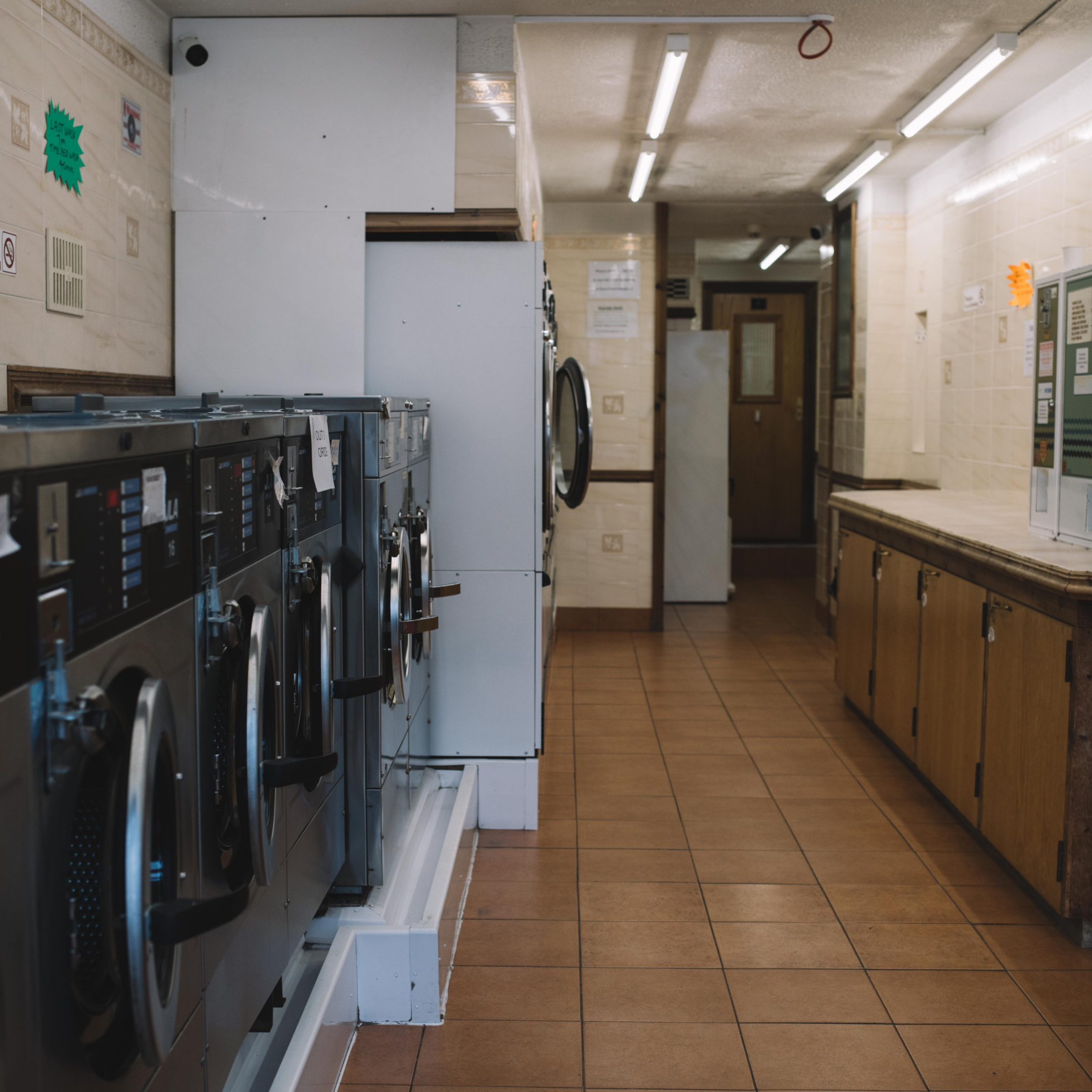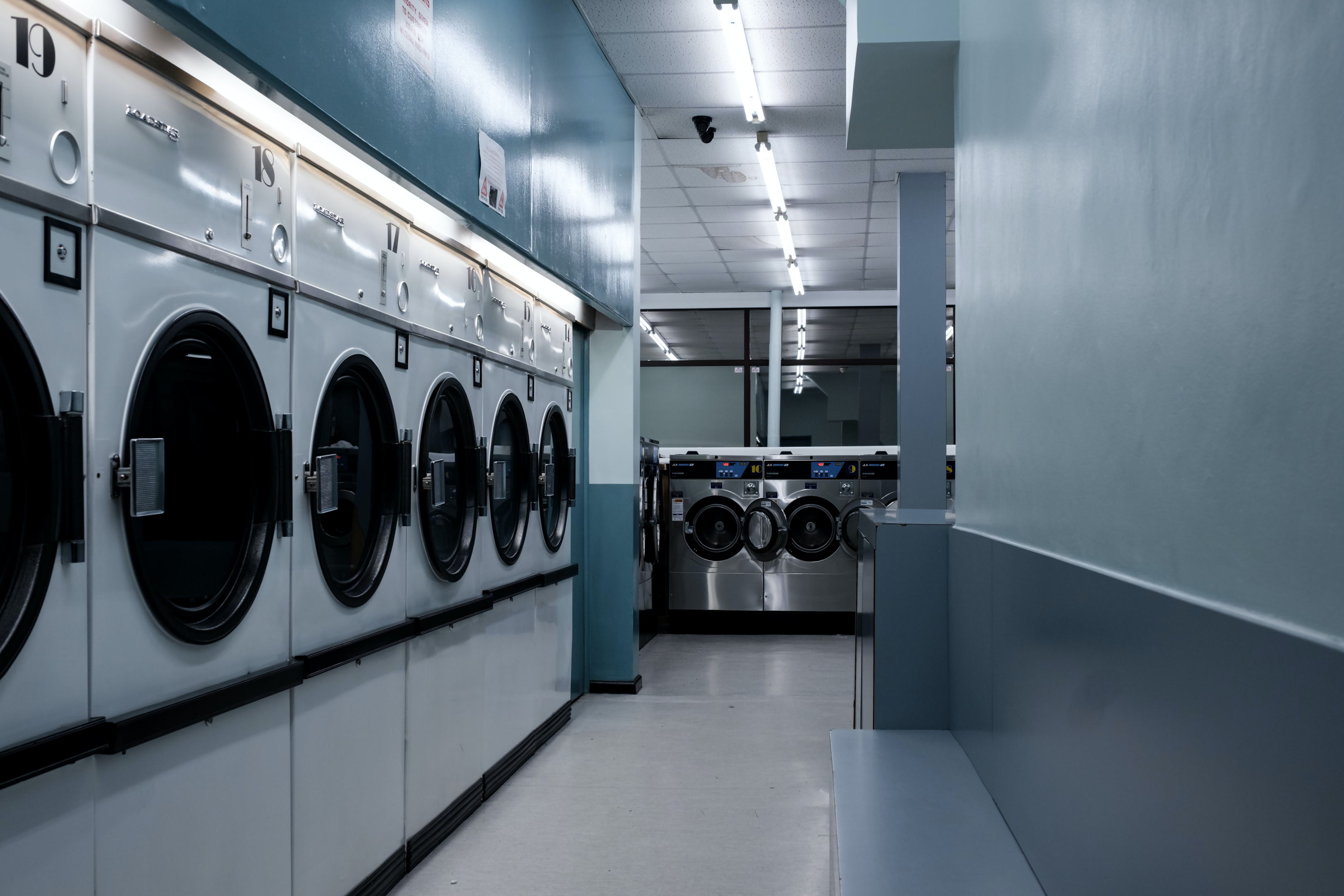Living in an apartment can bring a great sense of freedom and independence. Unfortunately, it can also bring a new list of responsibilities; one of them is washing and drying your laundry. Before you look for an apartment, you’ll want to consider the laundry situation. Will you look for an apartment with an onsite laundry facility for tenants? Or will you be better off in an apartment that has in-unit hookups or comes with a washer and dryer? On the other end of the spectrum, will you haul your dirty clothes to the laundromat or hire a laundry service?

In most areas, onsite and in-unit laundry is considered an amenity and comes with a higher cost for rent. Finding an apartment with laundry facilities in New York City (NYC), Chicago, or Los Angeles, can be challenging, whereas it’s a given in an apartment in the Midwest.
Regardless of where you live or are moving to, it’s essential to consider laundry facilities when determining if an apartment is right for you.
What does in-unit laundry mean?
In-unit laundry means that the apartment unit comes with a washer and dryer installed. In-unit washers and dryers are for use by the tenant living in that unit; no other tenant has access. They are appliances the building owner provides, just like a refrigerator, stove, or dishwasher.
In-unit laundry: the pros
You might feel like you’ve hit the rental jackpot if you score an apartment with in-unit laundry. Here are the advantages:
- Immediate availability: You can run a load of wash whenever you want and don’t need to leave your apartment. You can quickly put a load in to get after a stain and get your laundry going during commercial breaks while watching TV.
- Appliance use without ownership: You don’t need to purchase and move a washer and dryer into the unit when you rent an apartment with in-unit laundry machines. You have the perk of use whenever you want without the purchase expense.
- Self-service: Since you’ll be washing and drying your clothes yourself, you don’t have to pay for full-service laundry or wait a day or two for your clean laundry to be ready.
- Security: You don’t need to worry about having items taken from a community or public laundromat machine. With in-unit laundry, you won’t have this happen unless your friends borrow your clothes or the dryer starts eating your socks.
In-unit laundry: the cons
There are a few disadvantages to in-unit laundry:
- Higher rent: An in-unit laundry is considered an amenity, and you can expect to pay more rent. In some areas, in-unit laundry will add about 10% to your overall rent, or $100–$175 a month in a metro area like NYC.
- Increased utility costs: In-unit laundry will add to your utility costs for water and electricity.
- Decreased storage: In-unit laundry is typically housed in what would otherwise be a closet area, reducing closet space for storage.
- Risk of flood or other malfunction: If the washer malfunctions, you could have water, soap, and grime leaking all over your apartment; an electrical issue could cause a fire hazard or accidental mold growth.
- Increased maintenance and repairs: If your lease specifies it, you may be responsible for the maintenance and repairs of laundry machines in your unit.
- More cleaning responsibilities: You will be responsible for cleaning the washer and dryer to keep them in good working order.
Tips for keeping your in-unit washer and dryer clean
As a tenant, you are responsible for caring for appliances in your rental unit and handling routine maintenance. Here are some laundry tips to prevent wear and tear damage to the washer and dryer and keep them smelling fresh.
- Remove lint from the dryer lint trap regularly: The lint trap captures loose bits of fabric, pet hair, human hair, and other debris. Pull out the built-up lint in the screen after every few loads to keep the air in the dryer flowing and ensure your clothes dry quickly.
- Check your dryer vent regularly: Disconnect the venting at the back of the dryer every three months to check for lint buildup, which reduces airflow and can create a fire hazard.
- Clean the dryer drum: Wipe down the inside of the dryer every month using a rag and rubbing alcohol to remove any sticky or staining substances that may have accumulated on the drum; leave the dryer door open for proper ventilation.
- Clean out the washer drum: Mildew, soap scum, calcium, and other minerals found in water can build up in your washer drum over time. Every 6-8 months, fill your washer with hot water; add 1 cup of bleach and let it sit for an hour; pour some of the solution into the bleach dispenser and run the washer through a full wash drain cycle.
Complete the same process with 1 quart of white vinegar. Do not mix the vinegar and bleach or you will start a toxic chemical reaction. Run the cycle for 1 minute, then pause it for an hour; at the end of the hour, complete the cycle. Wipe down the machine’s exterior with a vinegar-water spray. Be sure to include the top of the washer drum on the interior; you can get the whole topside lip clean if you gently move it over to the side as you clean.
- Avoid overfilling: Don’t overload your washer or dryer. The washer can agitate and rinse smaller loads more effectively, and a smaller load in the dryer will come out faster, cleaner, and fresher than an overstuffed load.
- Air out your washer: Leave the washer door open after you empty a load so the interior can air dry completely, preventing mildew and mold.

What to consider before prioritizing in-unit laundry
If you wash clothes often – more than once a week, prioritizing in-unit laundry could make sense. You’ll need to budget for higher rent, utility payments, and potential maintenance if that’s your responsibility.
If you have a roommate or family, laundry needs will be ongoing so that in-unit laundry can be a no-brainer.
What is onsite laundry?
Onsite laundry means that the apartment building has community laundry facilities in the complex, available for use by all tenants. Onsite laundry is provided and maintained by the landlord or property management company, often with coin-operated or credit card equipment.
Onsite laundry avoids needing to haul laundry to a local laundromat, sit through each cycle, and haul it home again. With laundry facilities in the building, you could throw in a load and return to your apartment while you wait, a win-win compared to off-site laundry.
Onsite laundry: the pros
Here are a few advantages to onsite laundry.
- Convenience: With laundry facilities in the building, you can wash clothes whenever there is an open washer. Depending on how your community laundry room works, you might even be able to sign up for times to wash and dry your clothes.
- Cheaper rents: Typically, apartments with community laundry will rent for less than comparable buildings with in-unit laundry.
- Exclusive to tenants: Onsite laundry in a secured apartment building is for tenants’ use only. Facilities are not available to the public.
- No maintenance responsibilities: Building management will maintain and repair the machines when they need cleaning or are not functioning correctly. Tenants pay no extra costs for repairs.
- Space saver: You won’t have to give up closet storage to house a clothes washer and dryer.
Onsite laundry: the cons
While onsite laundry is convenient, you may need to work around other tenants’ schedules and sign up for a time to launder your clothes. You may also find that other tenants don’t respect the rules and remove your clothes to clean theirs.
- Schedule constraints: The onsite laundry may only operate at specific hours, and you may need to sign up to reserve your day and time. The saying “I can’t go out because I need to wash clothes” may become a sad reality if your onsite laundry schedule is packed.
- Shared machines: Tenants must respect the other’s rights to wash and dry their clothes according to the schedule or open time slot. Inconsiderate tenants use numerous machines at once, limiting others’ ability to do laundry at the same time – or they remove others’ laundry before a cycle is complete and take over the machine for their use.
- Transporting laundry: Hauling multiple loads of laundry from your apartment to the laundry facility can be burdensome and time-consuming.
- Time-consuming waits: With a shared facility, you may have to wait – a few minutes or a few hours – for other tenants to retrieve their laundry before you can start yours.
- Out-of-pocket costs: The cost to wash and dry a load of laundry in an onsite community laundry room can run from $1.50 to $4.00. Some apartment community facilities only accept quarters in their machines, which can require advance planning to ensure you have enough change to complete your wash.
Community laundry room tips
If your apartment building offers community laundry, here are a few simple etiquette tips to help keep the process smooth and pleasant for everyone.
- Presort your clothes: When you have your laundry time tightly scheduled, the last thing you want to do is waste your time or the time of others by arriving at the laundry room without your clothes sorted and ready to go, including emptying pockets and pre-treating any stains. Have your clothes treated, sorted, and ready to start your load before entering the laundry room.
- Clean up after yourself: Do your part to keep the laundry room clean and tidy. Detergent can spill and leave a sticky mess behind. Clean up any spills and wipe down the machine after use to leave the machine ready for the following user. Don’t forget to remove and throw away your dryer lint.
- Pay attention to your time: Be attentive to when you put your laundry in and know when the cycle will be done. The next tenant in line may remove your clothes from the machines if you leave them past your scheduled time. Set your phone timer to help remind you.
- Fold when you return to your apartment: Unless you know there’s no one scheduled right after you, bring your clean and dry clothes to your apartment to sort and fold.
- Schedule during downtimes: Ask your property manager when the laundry is used the least often. These downtimes could be the perfect time to have the laundry room all to yourself.

How to get your laundry done if in-unit or onsite laundry is not available
Purchase and install a washer and dryer if the apartment has hookups
- A washer needs a cold and hot water hookup and a 220-volt electric outlet. A dryer needs a 220-volt electric outlet and ducting to vent the hot air.
- You may need permission to hook up your own appliances even if your unit has the proper hookups. Your landlord or property management company may require you to hire a professional handyman or use their maintenance services for the job.
- Keep in mind that even with smaller-sized machines made for apartments, they take up a lot of space. You’ll likely lose storage to house the washer and dryer.
Request permission to install a washer and dryer combo for an apartment without hookups.
- Washer and dryer combos come as stacked units with a washer on the bottom and a dryer on top. Some washer and dryer combos are all-in-one machines that come vented or ventless; ventless machines don’t require ducting but need water hookups like other machines, but they are different sizes because they are smaller.
- Ask the property management if you can install a washer and dryer combo yourself or if they will require you to have a professional installation.
- Only requires 120 volt electrical and can plug into any outlet. These machines take up less space and are energy efficient but typically can handle only smaller loads.
Purchase a portable washer
You can opt for a portable washer if you want an in-unit laundry but don’t have space or hookups. You can find a portable washer for under $300. They are compact, usually around 1.6 cubic feet. They hook up to a faucet for the hot and cold water and drain directly into a sink. Portable dryers are also available in ventless or vented options.
Use your local laundromat
You’ll have to bag your laundry and haul it to a laundromat, but you can access multiple machines at once, which is helpful if you need to wash more than one load. Bring something to read or work on while you wait for your laundry.
Hire a laundry service
If you don’t have easy access to laundry facilities, you might find a wash, dry, and fold service. Typical costs range from $.90–$3 per pound of laundry.

Which is right for you – In-unit or onsite laundry?
When considering in-unit vs. onsite laundry, your lifestyle and budget will be the determining factors. If you have time to do offsite, you may not require an in-unit or onsite laundry facility. However, if you do a lot of laundry in a week and can afford to pay for convenience, an apartment with in-unit machines (or at least space to place a portable washer and dryer) will be your best bet. In-unit might cost you more rent and a little more each month for utilities; onsite laundry will cost you more in time.


























 United States
United States Canada
Canada